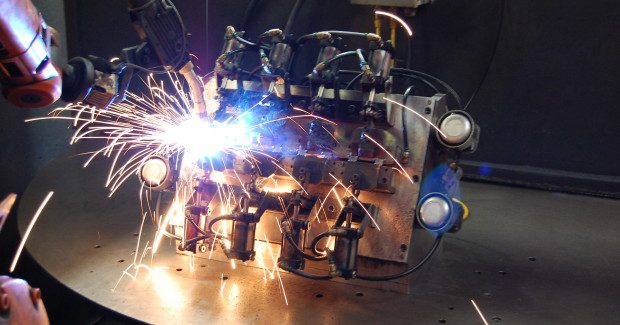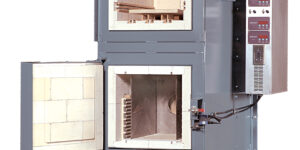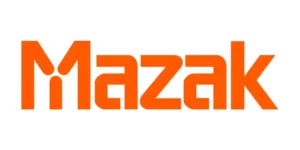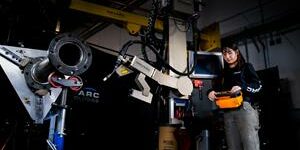THE ANSI / AWS WAY TO A SAFE WELDING WORKPLACE
U.S. welding engineers that use industrial arc welding robots can choose from a number of available voluntary industry standards to provide guidance on the subject of robot system safeguard selection. However, differences exist between a highly subjective matrix style of risk assessment and a more focused and structured risk assessment such as the AWS Protocol Method. Here are some reasons why the selection of proper safeguards should be a straightforward process that provides consistent results.
Posted: September 30, 2013
Normative references extend the scope of the requirements provided in the body of the standard. Both the ISO 10218 robot safety standard and the identical standard adopted by RIA include the following explanatory language: “The following referenced documents are indispensable for the application of this document. For dated references, only the edition cited applies.”
That statement is followed by the listing of seventeen ISO and five IEC standards documents. What is missing is any reference to ANSI standards or OSHA regulations. The American user is faced with the daunting task of becoming familiar with twenty two standards that are constantly in a state of revision and update. Simultaneously, the engineer is directed away from the entire cannon of ANSI B11 standards and other venerable ANSI standards such as NFPA 70 and 79.
AWS AND ISO: TWO DIFFERENT APPROACHES TO ROBOT WELDER SAFETY
The new ISO 10218 document mandates that a formal risk assessment be created for all robot systems using some form of the matrix format. The AWS approach is codified in the D16.3 risk assessment standard. The AWS risk assessment is a prescriptive form of safeguard selection and it relies upon the use of application based protocols in lieu of subjective matrices. The protocols are developed to reflect the real world application of welding robots in actual applications.
The two different styles of risk assessment do not represent merely a matter of semantics and personal preference. The desired risk assessment outcome is the selection of safeguards to mitigate a specific hazard. In virtually all cases the difference represents a choice between a structured rating system and an actual safeguard selection schedule.
Consider the case of the basic stand-alone robot welding system. Selection of proper safeguarding can be achieved by applying either the AWS methodology or the RIA/ ISO 10218 approach. The AWS method is prescriptive in nature while the ISO methodology is highly subjective and non-definitive. The AWS approach consists of applying the proper Safeguarding Protocol to the selected hazards. The RIA ISO approach requires that the system be analyzed with all safeguarding removed.
One of the most common hazards associated with any type of robot arc welding application is the generation of dangerous amounts of UV radiation at the arc source. In a typical example, a manual operator is loading and unloading sheet metal workpieces in a stationary fixture that is mounted on a stationary table. The process performed is the GMAW spot welding of two workpieces.
The task here of selecting the appropriate safeguards to mitigate the inherit hazards can include performing a risk assessment. The conclusions reached by using the RIA ISO method and the AWS method are very different. The RIA ISO risk assessment analysis yields a calculation consisting of a risk rating and the AWS method provides a schedule of specific guarding methods.
RIA / ISO ANALYSIS
The first step in the RIA / ISO process is the virtual removal of all existing safeguards from the work cell. With the guards removed the identified hazard selected for analysis, for this example welding related arc flash, is analyzed based on three fundamental characteristics:
- • S Level- Injury Severity
- • E Level- Exposure to the Hazard
- • A Level- Avoidance of the Hazard
Using the SEA analysis the engineer will likely conclude the following: Arc flash has been known to cause permanent eye damage; therefore the severity level is Serious; warranting a S3 rating. Exposure to the hazard without safeguards is pervasive and occurs every cycle of robot operation. Exposure is considered high, yielding a rating of E2. Since welding arc flash is light radiation it is impossible to avoid without safeguards. Avoidance is considered not likely resulting in a rating of A2.
In summary, the RIA ISO conclusion is that the identified hazard is serious and has Risk Reduction Priority of PR1. The corresponding Functional Safety Performance is PL d and Structure 3. In other words, the engineer does not receive any guidance concerning the mitigation of the hazard. He is simply left with a systemic affirmation of what was already understood before the risk assessment process was engaged.
AWS / ANSI PROCESS
The engineer refers to the AWS D16.3 risk assessment standard for guidance. The normative references guide the engineer to the AWS D16.1 robot safety standard. The specific safety protocol is determined by the Classification Tables found in D16.3.
After the analysis is complete the conclusion is straightforward. The welding arc flash hazard should be mitigated by the use of PPE in the form of proper eye protection. The process is unambiguous and direct. From D16.3, the Protocol 1 instructions state that safeguards must be provided to mitigate all environmental hazards. From D16.1, under sub-clause 7.5, protective eyewear PPE is recommended.
The proceeding risk assessment comparison illustrates the difference between a highly subjective matrix style of risk assessment and a more focused and structured risk assessment such as the AWS Protocol Method. Industrial safety is a serious business. This is true for all manner of industrial automation applications including the use of industrial robots to perform the arc welding process. The selection of proper safeguards should be a straightforward process and should provide consistent results.
My personal recommendation for the U.S. robot arc welding industry is this: In matters of robot welding safety: “Just Say No To ISO!”
Vern Mangold is a member of the at AWS D16 Committee and principal consultant at Kay Safety Consulting, 8535 Cherrycreek Drive, Dayton, OH 45458-3216, www.kaysafety.com.










